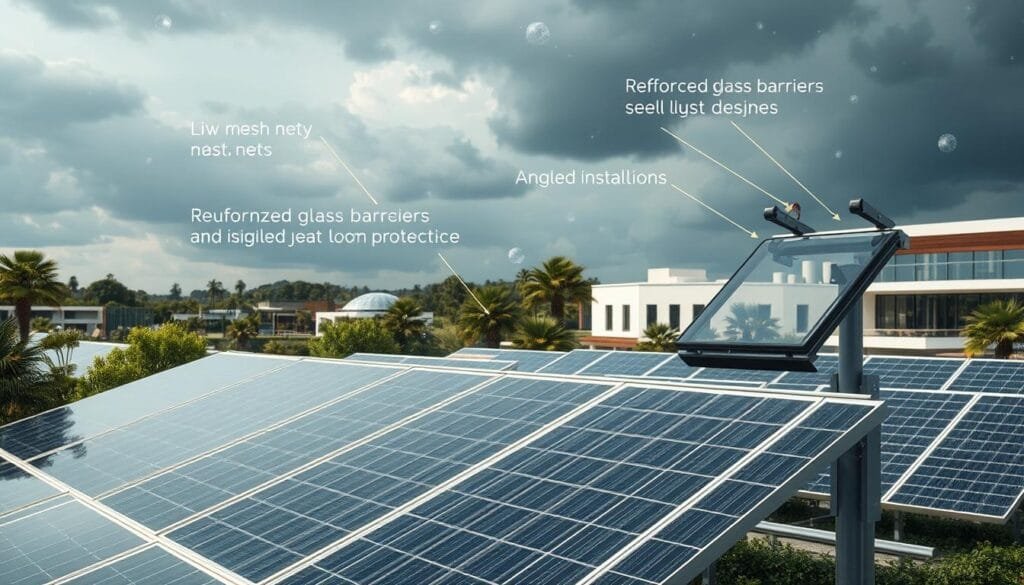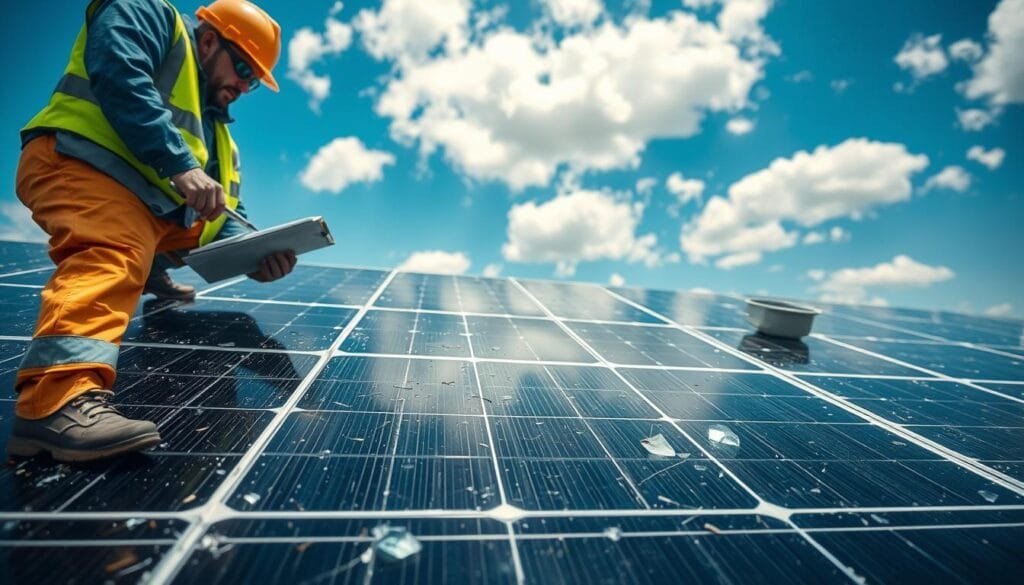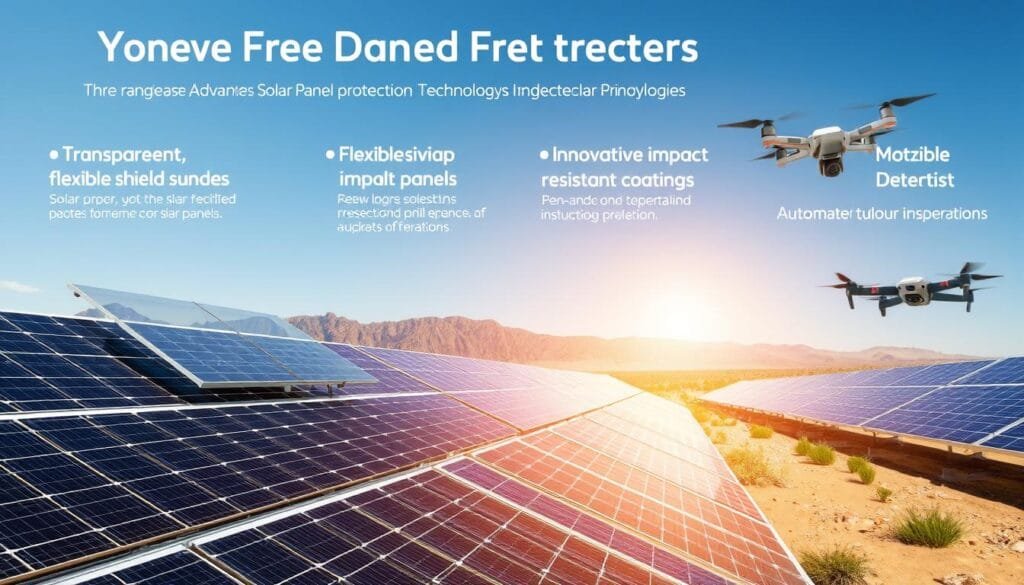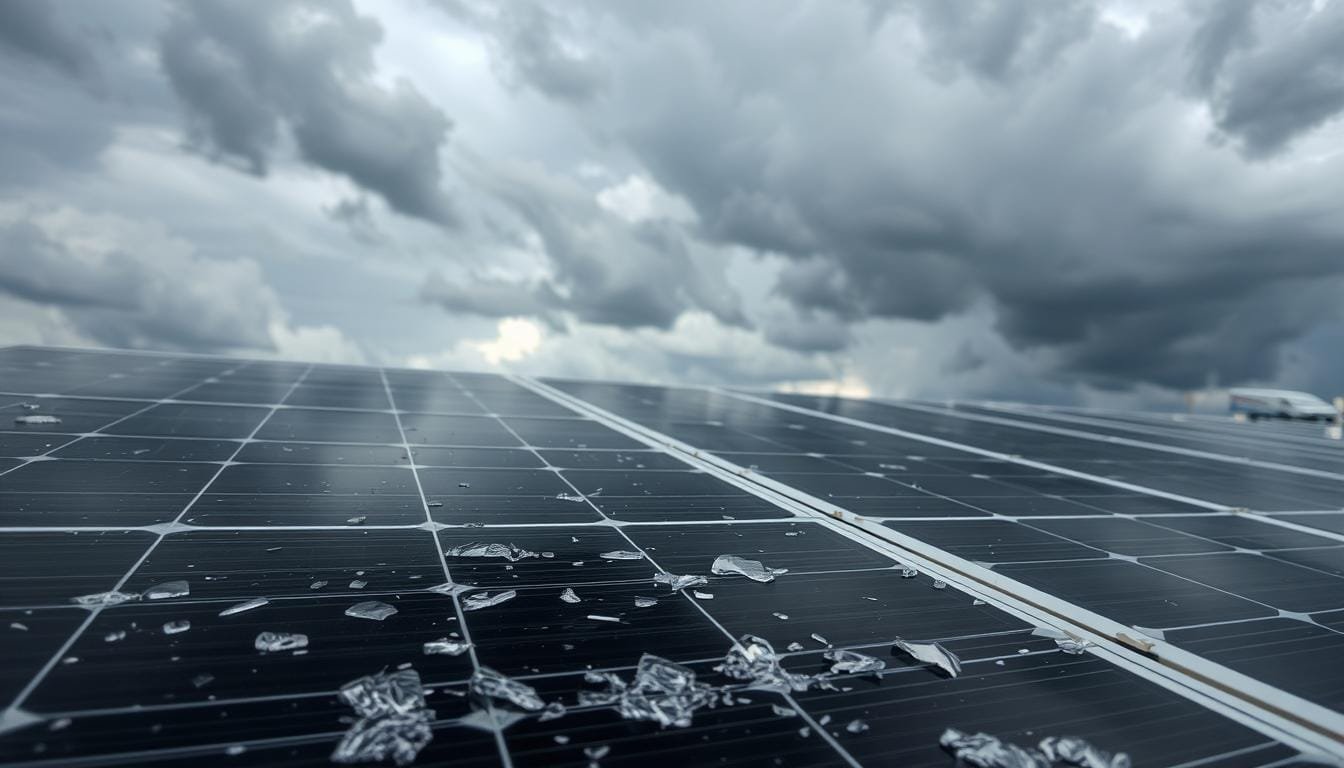In 2022, hail storms hit the United States hard, causing over $1 billion in damages. They pose a big risk to solar panels. States like Texas, Colorado, and Nebraska are most at risk due to frequent thunderstorms.
Protecting solar panels from hail is now a top concern for homeowners and investors. High-quality panels can handle hailstones up to 3 inches in diameter at speeds of 88.3 mph. But not all panels are created equal when it comes to withstanding hail.
It’s important to know how hail can affect solar panels. Hail can cause anything from minor scratches to serious damage. This can hurt the panels’ efficiency and lifespan.
Key Takeaways
- Hail storms can cause substantial damage to solar panels
- Peak hail season in the U.S. runs from March to October
- Solar panel damage varies from cosmetic scratches to structural cracks
- Not all warranties cover hail-related damage
- Professional inspection can help assess hail-related impacts
Understanding Hail Formation and Its Characteristics
Hail is a big threat to solar panels, mainly in areas with lots of thunderstorms. The way hailstones form is complex. It can damage solar panels and test how well they can handle weather.
Formation Process in Thunderstorms
Hailstones grow in thunderstorms’ strong updrafts. Water droplets get pushed into cold air. There, they freeze and grow bigger as they hit more cold water.
“Hail is nature’s unpredictable ice projectile, capable of causing significant damage to solar infrastructure.”
Hail Sizes and Fall Velocities
Hailstones vary a lot in size and speed. Here are some key facts:
- They can be as small as a pea or as big as a softball.
- They fall at speeds from 9 to 80 kilometers per hour.
- They can even make tiny cracks in solar panels.
Geographic Distribution of Hail Events
In the United States, hail is a big problem. It’s most common in what’s called “Hail Alley”. This includes:
- Nebraska
- Colorado
- Wyoming
These places are at the highest risk of hailstorms. So, it’s very important to make solar systems weather-proof for them.
Knowing how hail forms helps solar panel makers and owners. It helps them prevent damage and keep systems working well.
The Science Behind Solar Panel Construction
Solar panel engineering is a mix of materials science and design. Modern solar panels are made to last in tough weather, like hailstorms.
- Tempered glass protective layer
- Silicon photovoltaic cells
- Aluminum or steel framing
- Protective backsheet
Fixing solar panels often means keeping these parts safe. Hail resistant solar panels have special designs to handle impact better.
“Resilience is built into every layer of modern solar panel technology” – Solar Engineering Institute
There are different types of panels, each with its own impact resistance:
| Panel Type | Hail Resistance | Durability Rating |
|---|---|---|
| Monocrystalline | High | 95% |
| Polycrystalline | Medium | 85% |
| Thin-Film | Low | 75% |
Today’s solar panels are built to face the weather. They use strong glass that can handle hail up to 1 inch in diameter. This ensures they work well in many weather conditions.
How Hail Affects Solar Panel Performance
Solar panels are key to renewable energy, but they face big challenges from severe weather, like hailstorms. Knowing how hail affects solar panels is key to keeping them working well.
Hailstorms can harm solar panels a lot. The damage can range from small scratches to total failure. How much damage depends on the size and speed of the hailstones and the panel’s design.
Impact on Energy Generation
Hail can greatly lower solar panel efficiency in several ways:
- Visible surface cracks can block light
- Invisible microcracks can weaken the cells
- Photovoltaic cells work less well
Types of Physical Damage
Experts in solar panel repair see different kinds of damage from hailstorms:
| Damage Type | Potential Consequences | Severity |
|---|---|---|
| Surface Scratches | Less light absorption | Low |
| Microcracks | Performance drop | Medium |
| Structural Fractures | Panel failure | High |
Long-term Performance Implications
Hail damage can seriously affect solar panels over time. Even small damage can weaken panels and lower their performance.
“Quick checks and repairs are vital to avoid losing energy,” says Dr. Sarah Reynolds, a renewable energy expert.
Studies show that thicker glass (4 mm) panels resist hail better. For example, a 4 mm panel might lose only 1.1% of its power after hail, while a 2.8 mm panel could lose 21.8%.
Hail Damaged Solar Panels: Common Issues and Risks
Solar panels are made to face many environmental challenges. But, hail storms are a big risk to their structure and how well they work. It’s key to know the possible damages to keep solar energy systems running well.
Hail can cause serious problems with solar panels. These issues can affect how well they work and how long they last. Both visible and hidden damages can hurt the panels’ performance over time.
- Cracked glass surfaces
- Damaged solar cells
- Compromised electrical connections
- Micro-cracks invisible to naked eye
Studies from Vrije Universiteit Amsterdam show that hailstones over 3 cm can harm solar panels. Micro-cracks are a big problem. They can make panels work less well over time.
“Advanced inspection methods like Electroluminescence (EL) imaging are necessary to detect micro-cracks not visible during standard visual inspections.” – PVinsight RSA
Checking solar panels after hail is very important. Experts can find problems that aren’t easy to see.
| Hail Damage Type | Potential Impact | Recommended Action |
|---|---|---|
| Surface Scratches | Minor efficiency reduction | Visual inspection |
| Glass Cracks | Significant performance drop | Professional assessment |
| Micro-cracks | Long-term degradation | Advanced EL imaging |
Regular checks and care for solar panels can help avoid problems from hail. This keeps energy production steady and the system working for a long time.
Solar Panel Testing and Certification Standards
Ensuring the reliability of solar energy requires rigorous testing and certification processes. Hail resistant solar panels undergo extensive evaluations to guarantee their durability and performance in challenging weather conditions.
The solar industry has developed standards to protect solar energy reliability. These standards include detailed testing protocols. Two primary certification standards stand out in protecting solar panel integrity:
UL 61730 Certification Process
Underwriters Laboratories (UL) has established a robust certification method. It simulates real-world hail impact scenarios. The testing protocol includes:
- Dropping a 2-inch solid steel sphere from 51 inches
- Simulating hailstones up to 1.375 inches in diameter
- Firing calibrated ice balls at 52 miles per hour
IEC 61730 Testing Requirements
The International Electrotechnical Commission (IEC) provides another critical standard. Key requirements include:
- Resistance to 25mm hailstones
- Impact testing at speeds up to 83 km/hr
- Comprehensive evaluation of panel structural integrity
“One out of 3,168 solar panels at the NREL survived a destructive hail storm in May 2017, demonstrating remarkable resilience.”
Impact Resistance Ratings
Solar panel manufacturers now provide detailed impact resistance ratings. These ratings help consumers understand their product’s durability. They consider factors like:
- Hailstone size tolerance
- Impact velocity
- Structural glass strength
By implementing these stringent testing standards, the solar industry continues to enhance solar energy reliability. It protects consumers’ investments against hail damage.
Prevention Strategies for Hail Protection

Keeping solar panels safe from hail damage is key. It helps solar energy systems last longer and work better, even in areas with bad weather.
There are several ways to prevent hail damage:
- Choose hail-resistant solar panels with strong certifications
- Use protective cover systems
- Apply advanced positioning technologies
- Do regular maintenance and checks
Important prevention steps include:
- Panel Selection: Pick panels with UL 61730 certification. They can handle hail up to 3 inches in diameter at 88.3 miles per hour.
- Protective Covers: Soft covers protect without blocking sunlight
- Automated Positioning: Adjust panels to reduce hail impact during storms
“Proactive protection is always better than reactive repairs” – Solar Industry Expert
Places like Texas, Oklahoma, and Nebraska need extra care because of hail storms. With climate change making weather worse, protecting solar panels is more important than ever.
New tech like weather monitoring and special coatings can help a lot. Methacrylate spray-on protectants add extra defense. But, applying it right is key to keep energy efficiency.
Warranty Coverage and Insurance Considerations
Protecting your solar investment means knowing about warranties and insurance. Solar panel owners face special challenges, like severe weather in some areas.
Dealing with solar panel repair and replacement needs careful insurance review. Homeowners must understand their coverage well.
Manufacturer Warranty Limitations
Most solar panel makers offer limited protection against damage from the environment. Important warranty points include:
- Warranties usually last 10-25 years
- Many policies don’t cover certain weather damage
- Hail damage is often not fully covered
Insurance Policy Options
Homeowners can choose from several insurance options to safeguard their solar panels:
| Insurance Type | Coverage Scope | Typical Limitations |
|---|---|---|
| Homeowners Policy | Covers panels as home attachment | May require coverage limit increases |
| Specialized Solar Insurance | Comprehensive solar-specific protection | Higher premium but broader coverage |
Coverage Requirements
Protecting your solar panels needs careful planning. Key recommendations include:
- Check your current homeowners insurance policy
- Make sure it covers solar panel repair and replacement
- Think about extra insurance for full protection
Statistics show 5 million solar installations in America, with 97% on homes. This highlights the need for strong insurance.
Knowing your insurance choices can save you thousands, mainly in areas hit by hail like Colorado and Texas.
Solar Panel Design Features for Hail Resistance
Protecting solar investments means using design features that boost hail resistance. Hail resistant solar panels use advanced engineering to face severe weather. Now, makers create weather-proof solar systems that handle extreme conditions well.
- Thicker front glass (3.2mm recommended)
- Reinforced aluminum frame structures
- Enhanced support bars
- Tempered glass technology
“Solar panel resilience is not just about surviving a storm, but maintaining optimal performance afterward.”
Research shows key points about protecting solar panels. A major study found:
| Glass Thickness | Impact Test Performance |
|---|---|
| 2mm Glass | 97% failure rate |
| 3.2mm Glass | 87% survival rate |
Innovative tracking systems now offer extra protection by adjusting panel angles between 30 and 75 degrees during hail events. These new technologies greatly lower damage risks. They give solar panel owners peace of mind in areas prone to hail.
Companies like First Solar and SunPower lead in making panels durable. Thanks to smart engineering, solar panels can now handle hailstones up to 1 inch in diameter moving at 50 miles per hour.
Post-Hail Storm Inspection Protocol
After a hailstorm, it’s key to check your solar panels well. This helps keep them working right and lasting longer. Quick and detailed checks can stop damage and keep energy flowing.

Keeping your solar system in top shape needs a careful plan. Homeowners should know how to check their solar setup after a storm.
Visual Assessment Techniques
First, look closely at your panels for signs of hail damage. Homeowners should watch for:
- Visible cracks or fractures on solar panel surfaces
- Micro-punctures or impact marks
- Discoloration or irregularities in panel coating
- Loose or displaced mounting hardware
Professional Inspection Guidelines
While you can spot some damage yourself, experts bring more to the table. They use special tools:
- Thermal imaging to detect hidden microcracks
- Electroluminescence scanning for internal damage
- Electrical performance testing
- Structural integrity evaluation
“A thorough check can stop energy loss and costly fixes later.” – Solar Energy Experts Association
Homeowners in stormy areas should get pros to check their solar systems yearly. After big storms, get them checked too. This keeps your system running smoothly for years.
Maintenance Tips for Hail-Prone Areas
Keeping solar installations safe in areas hit by hailstorms is key. It involves regular solar array maintenance and making solar systems weather-proof. The National Renewable Energy Laboratory (NREL) says solar panels face less than a 5% chance of major hail damage. Yet, it’s important to take preventive steps.
“Proper maintenance is the key to ensuring long-term solar system performance in challenging weather conditions.”
Here are some effective maintenance tips for areas hit by hail:
- Do a visual check of solar panels every quarter
- Clear debris around the mounting structures
- Make sure panel tilt angles are right for protection
- Look at mounting hardware for any weak spots
Knowing how durable solar panels are helps protect your investment. Standard solar panel glass is 6-7 mm thick, which is strong against most hail. About 80% of hailstones are under 0.75 inches, which means less damage.
| Maintenance Activity | Frequency | Purpose |
|---|---|---|
| Visual Inspection | Quarterly | Detect any damage |
| Debris Clearing | Biannually | Stop secondary damage |
| Professional Assessment | Annually | Full system check |
Experts suggest using Leno Hail Netting. It lets 93-95% of sunlight through while adding extra protection against hail.
Cost Analysis: Repair vs. Replacement
Choosing between fixing or replacing solar panels is a big financial decision. Hail damage can really hurt how well your solar system works. This makes the choice very important for homeowners and businesses.
Several key factors influence the decision:
- Extent of physical damage
- System age and current performance
- Potential energy production improvements
- Long-term cost-effectiveness
Repairing solar panels is a good option when damage is minor. Common issues that can be fixed include:
- Faulty optimizers
- Microinverter problems
- Wiring disconnections
- Junction box malfunctions
“The average solar panel degrades by 0.5-0.75% annually, which impacts repair versus replacement decisions.”
Replacing solar panels might be better when:
- Panels are over 15 years old
- Damage is extensive
- Newer technologies offer significant efficiency gains
Thinking about the cost of replacing solar panels includes:
- Potential energy production improvements
- Decreasing technology costs
Modern solar panels can perform better and might lower your electricity bills over time.
Getting a professional opinion is key to deciding between repair and replacement. Talking to certified solar technicians can help figure out the best choice for your situation.
Advanced Protection Systems and Technologies
Solar panel hail protection has seen big changes in recent years. New technologies have come up to fight off damage. The solar world has realized the need for better ways to protect against hail, mainly in areas hit hard by storms.

Now, we have top-notch systems to lower the risk of hail damage. These new techs use smart designs and can predict when to act. They help keep solar investments safe.
Protective Covers and Innovative Solutions
Today’s solar panel protection includes some cool new ideas:
- Automated protective covers that go up when hail is coming
- Impact-resistant clear films
- Smart systems that quickly move panels
ARRAY Technologies has come up with a 77-degree stow capability for solar trackers. It’s the new standard for keeping panels safe from hail. This tech could even give up to 5% more energy than old systems.
Emergency Response Systems
New techs now link hail alert software with solar trackers. They have cool features like:
- Fast panel moving
- Max speed of 20°/min
- Acting fast and smart to avoid hail damage
The solar world is changing how it protects panels from hail. Now, panels are built to last longer, thanks to new materials and systems.
In 2021, hailstorms caused over $1 billion in damage to buildings. So, these advanced systems are a big deal for keeping solar setups strong.
Regional Considerations for Hail Risk
Solar energy faces big challenges from hail damage in the US. The risk of hail varies by region, affecting solar installations differently.
“Hail alley” runs from West Texas to the Dakotas, the most risky area for solar panels. NOAA says this area is hit hard by severe hail, which can harm solar systems.
“Understanding regional hail patterns is key to protecting solar investments and keeping energy reliable.” – Solar Industry Expert
Regional Hail Risk Breakdown
| Region | Hail Risk Level | Average Hail Diameter |
|---|---|---|
| Texas | High | 50-75 mm |
| Colorado | Very High | 40-60 mm |
| Nebraska | High | 35-55 mm |
| Midwest | Moderate | 25-45 mm |
For solar setups in hail-prone areas, consider:
- Testing modules for durability
- Using smart-stowing trackers
- Getting special insurance
- Positioning panels wisely
Tracker systems that can tilt during storms can help deflect hail and protect solar panels.
The 2019 Texas solar plant damage shows how vital it is to know about hail risks. This helps keep solar energy systems running smoothly.
Future Developments in Hail-Resistant Solar Technology
The solar industry is moving fast to make hail-resistant solar panels better. New tech is changing how solar panels handle extreme weather.
New ideas are making solar panels last longer. Companies like JinkoSolar and Trina Solar are at the forefront. They’re making big changes in design:
- Ultra-strong tempered glass compositions
- Self-healing polymer technologies
- Dynamic protection systems
- Advanced impact-absorption mechanisms
Some key tech advancements are:
| Technology | Performance Improvement |
|---|---|
| Tempered Glass | 5x stronger than heat-strengthened glass |
| Dual-Glass Modules | Enhanced wind and hail resistance |
| Stow Angle Technology | Reduces hail damage probability by up to 75% |
Climate change predictions show more hailstorms, making these techs key for solar energy reliability.
“The future of solar technology lies in creating panels that can withstand nature’s most challenging conditions.” – Solar Technology Research Institute
Hailstorms are getting more common, with 540 in June 2023. These new techs are vital for protecting solar investments and keeping energy flowing.
Conclusion
The world of solar energy is always changing, with hail damage being a big problem. Recent studies show that over 50% of solar industry losses come from hail. Texas alone saw over $300 million in damages from hail in 2022.
New technologies are making solar panels stronger against hail. Today’s panels can handle hailstones up to 1 ¾” in diameter at 50 miles per hour. This shows the solar industry’s effort to make panels more durable and reliable.
Homeowners and solar investors need to take steps to protect their panels from hail. They should choose panels with strong certifications, check them often, and use the latest protective tech. Knowing about the latest in solar panel design and protection helps make investments safer and more reliable.
The future of solar energy looks bright, despite challenges like hail damage. As research and technology advance, we’ll see even more durable solar solutions. These will help provide clean, reliable energy in many different weather conditions.

